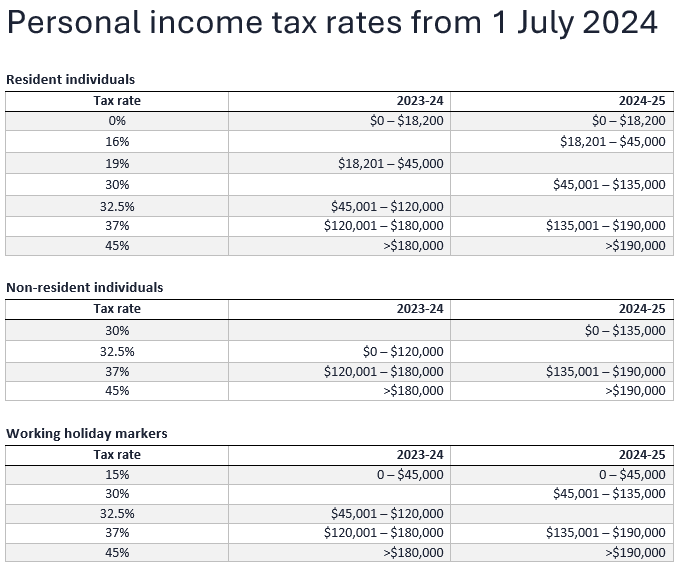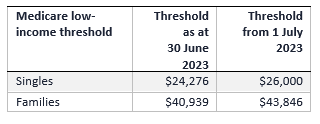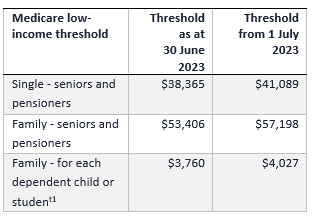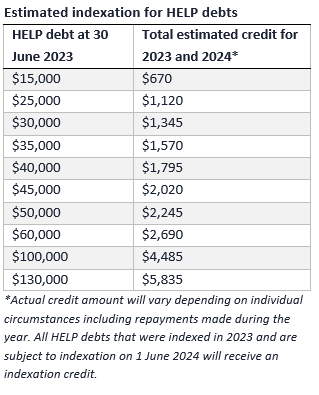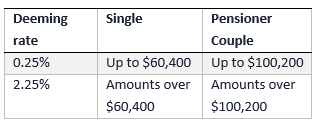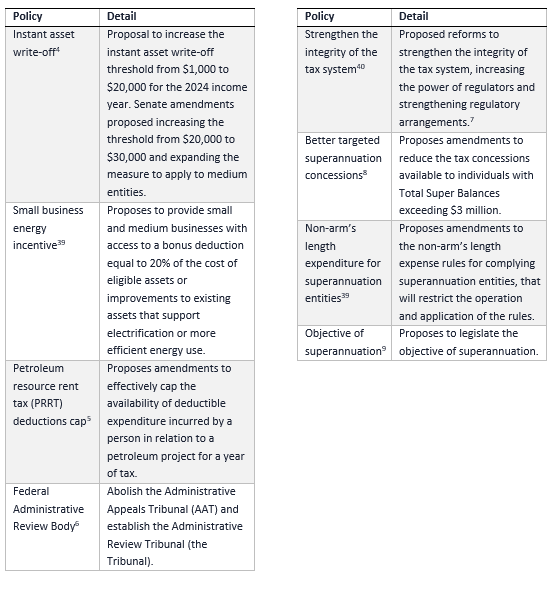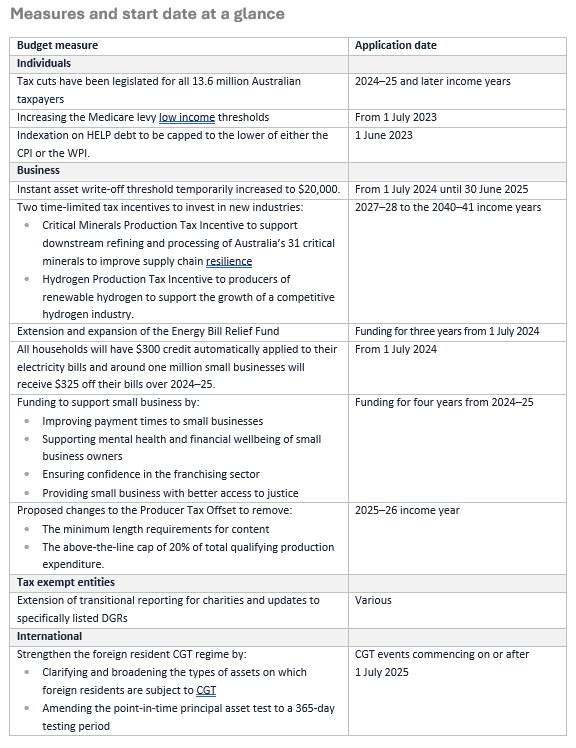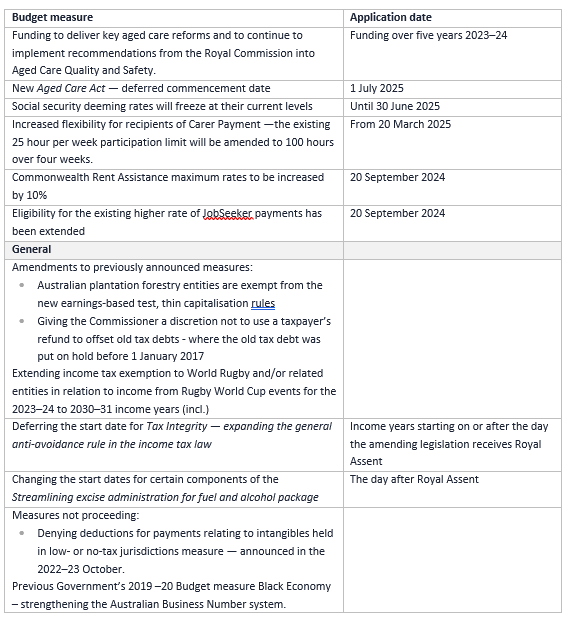‘The Price Is Right’ Budget 2024-25
The Price is Right: the Treasurer is promising that inflation will decline by 0.75% as a direct result of the 2024-25 Federal Budget initiatives.
The 2024-25 Federal Budget initiatives includes energy relief for all households, a boost to Commonwealth Rent Assistance, and the freezing of the maximum co-payment on the Pharmaceutical Benefits Scheme.
This is a pre-election budget for the people with everyone getting a little something to ease cost of living pressures.. Like the Price is Right gameshow, it will all come down to the price paid at the checkout. If the consumer price index (CPI) returns to target by the end of 2024 off the back of the Budget initiatives as the Government anticipates, the Reserve Bank of Australia (RBA) may be inclined to reduce interest rates. However, at this stage, the RBA is not expecting inflation to return to the target range of 2-3% until the second half of 2025, and to the midpoint in 2026.
The 2023-24 surplus has increased to $9.3bn but is expected to decline to a deficit of $28.3bn in 2024-25, driven primarily by the Stage 3 tax cuts.
For business, the Government is picking winners through targeted public investment with its Future Made in Australia Framework that they are betting will pave the way for private investment in net zero transformation and the strengthening of Australia’s domestic economic resilience.
For small and medium business, there is a little but not a lot - an extension of the $20k instant asset write-off until 30 June 2025 and a $325 rebate to eligible businesses towards 2024-25 energy bills.
For foreign residents, the capital gains tax (CGT) regime will be amended to broaden the type of assets subject to CGT and introduce a modified 365-day principal asset testing period.
Key measures:
Previously announced Stage 3 tax cuts.
$300 energy bill relief for all Australian households and $325 for eligible small businesses - applied as an automatic quarterly credit.
Student HELP debts will be cut by changing the way indexation is calculated. From 1 June 2023, it will be the lower of the CPI or the Wage Price Index (WPI), reducing the debt accumulated by more than 3 million Australians when the CPI spiked to 7.1%.
Increase to the Commonwealth rent assistance maximum rates by 10% from 20 September 2024.
One year freeze on the maximum Pharmaceutical Benefits Scheme (PBS) patient co-payment for Medicare card holders and a five-year freeze for pensioners and other concession cardholders.
What wasn’t in the Budget?
Those with large superannuation balances will be disappointed that the 30% tax on super earnings on balances above $3 million remains in place, this is set to commence from 1 July 2025.
If we can assist you to take advantage of any of the Budget measures, or to risk protect your position, please let us know.
As always, we’re here if you need us!
Individuals & families
Personal income tax cuts CONFIRMED
FROM JULY 2024
As previously announced, the Government has legislated permanent tax cuts for all Australian taxpayers from 1 July 2024.
Relative to the previous Stage 3 plan, the redesigned cuts broaden the benefits of the tax cut by focussing on individuals with taxable income below $150,000.
For Personal income tax rates from 1 July 2024, see the below table:
See Treasury Laws Amendment (Cost of Living Tax Cuts) Bill 2024 .
Medicare levy low-income thresholds increase
FROM 1 JULY 2023
The Medicare levy low-income thresholds will be increased for singles, families, and seniors and pensioners from 1 July 2023.
The increases to the thresholds take account of recent movements in the CPI so that low-income taxpayers generally continue to be exempt from paying the Medicare levy.
[1] For each dependent child or student, the family income threshold increases by the stated amount.
$300 energy relief for households
Households will receive a credit of $300 on their energy bills credited as automatic quarterly instalments across 2024-25.
Energy relief will also be provided to eligible small businesses in the form of a $325 rebate.
Costing $3.5bn over three years from 2023-24, the measure extends and expands the Energy Bill Relief Fund.
See Media release: New power bill relief
Capping indexation of HELP debts
LOAN ACCOUNTS THAT EXISTED ON 1 JUNE 2023
As previously announced, the Government will cap the HELP indexation rate to be the lower of either the CPI or the Wage Price Index (WPI) with effect from 1 June 2023. The change will apply to all HELP, VET Student Loans, Australian Apprenticeship Support Loans and other student support loan accounts that existed on 1 June 2023.
By changing the calculation of HELP indexation from 1 June 2023, the indexation rate is reduced from:
• 7.1% to 3.2% in 2023, and
• 4.7% to around 4% in 2024.
The change resolves an issue for more than 3 million Australians with a HELP debt when the CPI indexation rate spiked to 7.1% last year.
An individual with an average HELP debt of $26,500 will see around $1,200 wiped from their outstanding HELP loans this year, pending the passage of legislation.
See Media Release: Cutting student debt for more than three million Australians
Superannuation on paid parental leave
FROM 1 JULY 2024
As previously announced, from 1 July 2025 superannuation will be paid on Paid Parental Leave payments from 1 July 2025.
Eligible parents will receive an additional payment based on the superannuation guarantee (i.e. 12% of their PPL payments), as a contribution to their superannuation fund.
This payment is in addition to the changes that saw families provided with an extra two weeks of leave (22 weeks total), which will increase to 24 weeks from July 2025 and 26 weeks from July 2026 (see Paid Parental Leave Amendment (More Support for Working Families) Bill 2023, Royal Assent 20 March 2024).
Increasing commonwealth rent assistance
FROM 20 SEPTEMBER 2024
The Commonwealth rent assistance maximum rates will increase by 10% from 20 September 2024.
Recipients of Centrelink/Department of Veterans Affairs payments and those receiving family tax benefit may also receive rent assistance if they are paying rent or other rent like payments over a minimum fortnightly threshold.
The current maximum fortnightly rates are $188.20 for a single person and $177.20 combined for a couple.
The measure will cost $1.9 billion over five years from 2023–24 (and $0.5 billion per year ongoing from 2028–29), and builds on the 15% increase in September 2023, taking the maximum rates over 40% higher than in May 2022.
Improving aged care support
The Government will provide funding of $2.2 billion over the next five years to deliver key aged care reforms and to continue to implement recommendations from the Royal Commission into Aged Care Quality and Safety.
This funding includes the release of an additional 24,100 home care packages in 2024-25.
The Government has also agreed to defer the commencement date of the new Aged Care Act to 1 July 2025.
The Government is currently in the middle of considering and implementing changes to the way aged care is funded on the back of the Royal Commission into Aged Care Quality and Safety report released in 2021.
This will likely impact home care and residential care fees in the future. Generally, with past reform we have seen existing residents and home care recipients ‘grandfathered’ under the rules at the time they entered.
Increased flexibility for carer payment
FROM 20 MARCH 2025
Currently, to receive the Centrelink Carer Payment, the care giver is required to not be involved in work, study or training for more than 25 hours per week. This is to reflect the requirement that to receive this payment the care giver should be providing the care recipient with ‘constant care’.
From 20 March 2025, the existing 25 hours per week will be amended to 100 hours over four weeks.
This limit will no longer capture study, volunteering and travel time so will only apply to employment.
In addition:
• Carer Payment recipients exceeding the participation limit or their allowable temporary cessation of care days will have their payments suspended for up to six months, rather than cancelled.
• Recipients will also be able to use single temporary cessation of care days where they exceed the participation limit, rather than the current seven day minimum.
Higher JobSeeker rate for partial capacity to work
FROM 20 SEPTEMBER 2024
The Government will extend eligibility for the existing higher rate of JobSeeker payment to single recipients with a partial capacity to work (zero to 14 hours per week) from 20 September 2024.
Currently, those on JobSeeker payments aged 55 or over and who have been on the payment for nine continuous months receive a higher rate of payment. These are:
Freezing social security deeming rates
FROM 12 MONTHS UNTIL 30 JUNE 2025
When calculating Centrelink and Department of Veterans affairs payments, rather than assessing the actual income from financial investments, a deemed rate of return based on the total value of these investments is assumed. Some common examples of financial investments include bank accounts, term deposits, shares and managed funds.
The Government proposes to freeze the deeming rates (shown below) until 1 July 2025:
Pharmaceutical Benefits Scheme co-payments
FROM 1 JANUARY 2024
The Government will ensure that the cost of medicines remains low by freezing indexation:
PBS general co-payments to not be indexed between 1 January 2025 and 31 December 2025 (inclusive), with indexation resuming on 1 January 2026
PBS concessional co-payments to not be indexed between 1 January 2025 and 31 December 2029 (inclusive), with indexation resuming on 1 January 2030
The $1 optional discount available on patient co-payments for subsidised prescriptions will be reduced each year by the relevant notional indexation amount until the $1 discount has been reduced from $1 to zero.
From 1 January 2024, you may pay up to $31.60 for most PBS medicines, or $7.70 if you have a concession card. The Australian Government pays the remaining cost (with the exception of brand premiums and certain other allowable charges).
Federal, state and territory governments focus on housing
FROM 1 JANUARY 2024
Housing initiatives address three key areas:
Private commercial development of future housing supply – the Government has outlined an ambitious goal of building 1.2 million homes by the end of the decade. The 2023-24 Budget announced new measures to encourage investment and development of housing, particularly build-to-rent developments that included affordable housing. However, the draft legislation enabling the announced incentives has only recently been released by Treasury. It is difficult to encourage large scale investment if you do not follow through with legislation which provides certainty. No new measures have been announced to date.
Support to help ease the path to home ownership for first home buyers – also a policy dominant in the 2023-24 Budget with $5.5bn over a decade committed to the Help to Buy scheme. No new incentives have been announced to date.
Crisis and social housing support – the Government has announced $1bn directed towards crisis and transitional accommodation for women and children fleeing domestic violence, and youth. This measure is on top of the 15% increase to Commonwealth Rent Assistance in the 2023-24 Budget.
As previously announced, much of the Budget funding however flows to the States and Territories to increase housing stock, increase social housing, and provide crisis accommodation. New measures include:
$1bn for states and territories to build the roads, sewers, energy, water and community infrastructure; and
A new $9.3 billion 5‑year National Agreement on Social Housing and Homelessness – for states and territories to combat homelessness, provide crisis support and build and repair social housing. This includes a doubling of Commonwealth homelessness funding to $400 million every year, matched by states and territories.
See Media Release: Multi-billion-dollar investment to build more homes for Australians & Treasury consultation: Build-to-rent tax concessions
Domestic violence
FROM MID-2025
As previously announced, the Government has committed almost $1bn over 5 years to permanently establish the Leaving Violence Program – so those escaping violence can receive financial support, safety assessments and referrals to support pathways. Those eligible will be able to access up to $5,000 in financial support along with referral services, risk assessments and safety planning.
See Media Release: Helping women leave a violent partner payment
Superannuation & investors
Expanding CGT regime for foreign residents
CGT EVENTS COMMENCING ON OR AFTER 1 JULY 2025
The foreign resident capital gains tax (CGT) regime will be expanded by:
Clarifying and broadening the types of assets on which foreign residents are subject to CGT
Amending the point-in-time principal asset test to a 365-day testing period
Requiring foreign residents disposing of shares and other membership interests exceeding $20 million in value to notify the ATO, prior to the transaction being executed.
Under current law, foreign residents are subject to CGT when they sell an asset that is classified as ‘taxable Australian property’ (TAP). The rules seek to ensure that non-residents are subject to Australian CGT on the disposal of assets that have a sufficient with Australian land and assets that have been used in business activities in Australia..
Shares in a company and units in a trust can be classified as TAP if the taxpayer and certain related parties hold at least a 10% interest in the entity and where more than 50% of the gross market value of the assets held by the entity is attributable to real property located in Australia and similar assets.
The measure is intended to ensure that Australia can tax foreign residents on direct and indirect sales of assets with a close economic connection to Australian land, bringing the treatment more in line with the tax treatment that already applies to Australian residents.
The new ATO notification process will improve oversight and compliance with the foreign resident CGT withholding rules, where a vendor self-assesses the sale doesn’t involve TAP.
The proposed reforms will also align Australia’s tax law for foreign resident capital gains more closely with OECD standards and international best practice.
The Government will consult on the implementation details of the measure, which is estimated to increase receipts by $600 million and increase payments by $8 million over the five years from 2023–24.
Business & employers
$325 energy relief for small business
FROM 1 JULY 2024
Around one million small businesses will receive $325 off their energy bills over 2024–25. The support will apply as an automatic quarterly credit to energy bills.
Energy relief will also be provided to households in the form of a $300 rebate.
Costing $3.5bn over three years from 2023-24, the measure extends and expands the Energy Bill Relief Fund.
$20,000 small business incentives for energy efficiency
FROM 1 JULY 2023 TO 30 JUNE 2024
As previously announced, the Small Business Energy Incentive provides an additional deduction of 20% of the cost of eligible depreciating assets that support electrification and more efficient use of energy.
Up to $100,000 of total expenditure will be eligible, with a maximum bonus deduction of $20,000.
The incentive is available to small and medium businesses with aggregated annual turnover of less than $50 million.
While the full detail of what qualifies for the incentive is not yet available, it is expected to apply to a range of depreciating assets and upgrades to existing assets such as electrifying heating and cooling systems, upgrading to more efficient fridges and induction cooktops, and installing batteries and heat pumps.
Some exclusions will apply including electric vehicles, renewable electricity generation assets, capital works, and assets that are not connected to the electricity grid and use fossil fuels.
Eligible assets or upgrades will need to be first used or installed ready for use between 1 July 2023 and 30 June 2024 to qualify for the bonus deduction.
See Media release: New power bill relief
$20k Small business instant asset write-off extended
FROM 1 JULY 2023 - 30 JUNE 2025
Small businesses, with an aggregated turnover of less than $10 million, will be able to immediately deduct the full cost of eligible depreciating assets costing less than $20,000 that are first used or installed ready for use between 1 July 2023 and 30 June 2025. This measure extends the 2023-24 Budget announcement to the 2024-25 financial year.
“Immediately deductible” means a tax deduction for the asset can be claimed in the same income year that the asset was purchased and used (or installed ready for use).
If the business is registered for GST, the cost of the asset needs to be less than $20,000 after subtracting the GST credits that can be claimed for the asset. If the business is not registered for GST, it is less than $20,000 including GST.
The write-off applies per asset, so a small business can deduct the cost of multiple assets.
The rules only apply to assets that fall within the scope of the depreciation provisions. Expenditure on capital improvements to buildings that falls within the scope of the capital works rules is not expected to qualify.
Assets valued at $20,000 or more (which cannot be immediately deducted) can continue to
be placed into the small business simplified depreciation pool and depreciated at
15% in the first income year and 30% each income year thereafter if the asset has been acquired by a small business entity that chooses to apply the simplified depreciation rules.
The provisions that prevent small businesses from re-entering the simplified depreciation regime for 5 years if they opt-out will continue to be suspended until 30 June 2025.
The increased small business instant asset write-off announced in the 2023-24 Federal Budget is not yet law, see Treasury Laws Amendment (Support for Small Business and Charities and Other Measures) Bill 2023). Senate amendments proposed increasing the threshold from $20,000 to $30,000 and expanding the measure to apply to medium entities.
Resources: Media Release: Budget delivers for Australia’s small businesses
The Future Made in Australia initiative
The Government has announced a bold initiative to make Australia a “renewable energy superpower.”
The $22.7 billon series of initiatives is designed to foster and encourage significant private sector investment into priority industries necessary to harnessing the economic and industrial benefits of the move to net zero and securing Australia’s place in a changing global economic and strategic landscape.
The Future Made in Australia Act will establish the policy framework - the focus will be on industries in which Australia has a genuine economic advantage, where it contributes to an orderly path to net zero, where it builds on the capabilities of the people and regions and improves Australia’s national security and economic resilience.[2].
[2] Treasurer, Jim Chalmers, Address to the Lowy Institute, Sydney, 1 May 2024.
Making Australia a renewable energy ‘super power’
FROM 2027-28 to 2024-41
As part of the Future Made in Australia initiative, the Government will provide an estimated $19.7 billion over ten years from 2024–25 to accelerate investment in Future Made in Australia priority industries including renewable hydrogen, green metals, low carbon liquid fuels, refining and processing of critical minerals and manufacturing of clean energy technologies including in solar and battery supply chains.
This includes two time‑limited tax incentives to invest in new industries:
Critical Minerals Production Tax Incentive from 2027-28 to 2040-41 to support downstream refining and processing of Australia's 31 critical minerals to improve supply chain resilience.
the production incentive will be valued at 10% of relevant processing and refining costs
applicable for up to 10 years per project for production between 2027-28 and 2039-40 by projects that reach final investment decisions by 2030.
a Hydrogen Production Tax Incentive from 2027-28 to 2040-41 to producers of renewable hydrogen to support the growth of a competitive hydrogen industry and Australia's decarbonisation.
The incentive will be $2 per kilogram of renewable hydrogen produced for up to 10 years per project for production between 2027-28 and 2039-40 by projects that reach final investment decisions by 2030.
Details are subject to consultation.
The tax incentives are proposed to be in effect from the 2027–28 to the 2040–41 income years.
Funding measures
The Government is getting into business with industry to encourage investment in select areas:
$10.2 million in 2024–25 for pre-feasibility studies for critical mineral common-user processing facilities in partnership with state and territory governments to enhance Australia’s capacity to process critical minerals, sovereign capability and economic resilience.
· $1.3 billion over ten years from 2024–25 (and an average of $151.6 million per year from 2034–35 to 2038–39) for an additional round of the Hydrogen Headstart program to bridge the green premium for early-mover renewable hydrogen projects.
· $17.1 million over four years from 2024–25 (and an additional $2.5 million in 2028–29) to deliver the 2024 National Hydrogen Strategy, including hydrogen infrastructure planning, social license and industry safety training and regulation.
· $1.5 billion over seven years from 2027–28 (and an average of $125.0 million per year from 2034–35 to 2036–37) to the Australian Renewable Energy Agency to invest in renewable energy and related technologies.
$1.7 billion over ten years from 2024–25 for the Future Made in Australia Innovation Fund (administered by the Australian Renewable Energy Agency), to pilot and demonstration projects and early stage development in priority sectors, including renewable hydrogen, green metals, low carbon liquid fuels and clean energy technology manufacturing such as batteries.
$1.4 billion over 11 years from 2023–24 (and $66.8 million per year from 2034–35 to 2036–37) to support manufacturing of clean energy technologies including solar and battery manufacturing.
$20.9 million over four years from 2024–25 (and $1.2 million per year ongoing) to undertake further consultation on incentives to support the production of, and demand for, low carbon liquid fuels.
$18.1 million over six years from 2024–25 for foundational initiatives to expedite the emergence of Australia’s green metals industry.
$11.4 million over four years from 2024–25 (and $1.1 million per year ongoing) to fast track the initial phase of the Guarantee of Origin Scheme for green hydrogen and bring forward work on green metals, including iron, steel and aluminium.
Resources: Media release: New power bill relief
Film producer tax offset
DATE 2025-26 INCOME YEAR
The Producer Tax Offset is a refundable tax offset for Australian expenditure in making Australian films when certain conditions are met. The amount of the offset is:
40% of the company’s qualifying Australian production expenditure (QAPE) on a feature film
20% of the company’s total QAPE on a film that is not a feature film.
The minimum duration requirement differs depending on the format of the production.
As part of the Government’s announced National Cultural Policy, it will make the changes to the Producer Tax Offset from 2025–26 to remove:
The minimum length requirements for content
The above-the-line-cap of 20% of total QAPE.
Small business support services
DATE OVER 4 YEARS FROM 2024-25
The Government has announced $41.7 million in funding over four years from 2024–25 for a series of initiatives to support small businesses:
Improving payment times to small businesses including naming and shaming - increased resourcing for the Payment Times Reporting Regulator so that it can deliver its expanded functions, which include naming slow paying businesses.
Mental health and financial wellbeing of small business owners –
Extending the NewAccess for Small Business Owners program, which provides tailored, free and confidential mental health support.
Extending the Small Business Debt Helpline.
Franchising sector code changes - In response to the 2023 Schaper Review of the Franchising Code of Conduct, the Government is providing $3 million to:
Remake and improve the Code.
Promote best practice conduct between franchisors and franchisees.
Make it easier for small businesses to operate in the sector including through better access to dispute resolution.
Access to justice - $2.6m in funding to the Australian Small Business and Family Enterprise Ombudsman. The ASBFEO assists and advocates for small businesses including helping to resolve disputes
Government & regulators
Modernising Digital Assets and Payments Regulation
FROM 2024-25
$7.5 million over four years from 2024–25 (and $1.5 million per year ongoing) has been provided to modernise regulatory frameworks for financial services to improve competition and consumer protections for services enabled by new technology.
The Government will:
develop and consult on legislation to licence and regulate platforms that hold digital assets and progress related reforms, including continuing exploratory work on Central Bank Digital Currencies, asset tokenisation and decentralised finance
Introduce a new regulatory framework for payment service providers (including digital wallets and electronic stored value providers), including licensing and a mandated ePayments Code.
Extension of transitional reporting for charities
The current charity transitional reporting arrangement will be extended for five years.
The Government will remake the Australian Charities and Not-for-profits Commission (Consequential and Transitional) Regulation 2016 with an extension of the current charity transitional reporting arrangement for five years.
The purpose of the regulation is to reduce the regulatory reporting burden on certain not-for-profit entities (registered entities) under the Australian Charities and Not-for-profits Commission Act 2012 (the ACNC Act) by providing that the ACNC Commissioner may treat a statement, report or other document given under an Australian law to an Australian Government agency by a registered entity as satisfying certain reporting obligations under the ACNC Act.
ATO counter fraud strategy
FIRST INCOME YEAR AFTER ROYAL ASSENT OF ENABLING LEGISLATION
The Government announced that it will provide $187 million over four years from 1 July 2024 to the ATO to strengthen its ability to detect, prevent and mitigate fraud against the tax and superannuation systems.
Funding includes:
$78.7 million for upgrades to information and communications technologies to enable the ATO to identify and block suspicious activity in real time.
$83.5 million for a new compliance taskforce to recover lost revenue and intervene when attempts to obtain fraudulent refunds are made.
$24.8 million to improve the ATO’s management and governance of its counter-fraud activities, including improving how the ATO assists individuals harmed by fraud.
$0.4 million over four years from 1 July 2024 to the Department of Finance to undertake a Gateway Review process over the life of the proposal to ensure independent assurance, oversight and delivery of the measure.
The Government will also strengthen the ATO’s ability to combat fraud by extending the time the ATO has to notify a taxpayer if it intends to retain a business activity statement (BAS) refund for further investigation. The ATO’s mandatory notification period for BAS refund retention will be increased from 14 days to 30 days to align with time limits for non-BAS refunds.
The extended period will strengthen the ATO’s ability to combat fraud during peak fraud events like the one that triggered Operation Protego. Legitimate refunds will be largely unaffected. Any legitimate refunds retained for over 14 days would result in the ATO paying interest to the taxpayer - as is currently the case. The ATO will publish BAS processing times online.
This measure is estimated to increase receipts by $302.2 million and increase payments by $187.4 million over the five years from 2023–24.
Funding ATO priority targets
Specific funding has been provided to the ATO for key targets. These include:
Personal income tax - The ATO’s Personal Income Tax Compliance Program will be extended for one year from 1 July 2027. This measure is estimated to increase receipts by $180.3 million and increase payments by $44.3 million over the 5 years from 2023–24.
The shadow economy - the ATO’s Shadow Economy Compliance Program will be extended for two years from 1 July 2026. This measure is estimated to increase receipts by $1.9 billion and increase payments by $610.2 million over the 5 years from 2023–24. This includes an increase in GST payments to the states and territories of $429.6 million.
Anti-avoidance taskforce - extend the ATO’s Tax Avoidance Taskforce for two years from 1 July 2026. This measure is estimated to increase receipts by $2.4 billion and increase payments by $1.2 billion over the 5 years from 2023–24.
The Tax Avoidance Taskforce has a strong focus on the top 1,100 public and multinational businesses and the top 500 privately owned groups, but also covers all 5,000 high wealth private groups that control net wealth exceeding $50 million and public and multinational businesses outside of the ATO’s justified trust programs.
As of 30 June 2023, the taskforce has assisted the ATO raise $32.7 billion in tax liabilities.
Child care providers - $4.8 million over four years from 2024–25 to ensure satisfactory engagement with the Australian tax system regarding fitness and propriety requirements of existing and new child care providers (relating to the Child Care Subsidy Program).
Identify checking - $155.6 million over two years from 2024–25 to continue operating and improving the Government’s Digital ID, myGovID, and the system which supports authorised access to a range of government business services.
Migrant workers - $1.9 million in 2024–25 for a data-matching pilot between the Department of Home Affairs and the ATO of income and employment data to mitigate exploitation of migrant workers and abuse of Australia’s labour market and migration system.
E-invoicing - $23.3 million over four years from 2024–25 to continue to oversee and operate the secure eInvoicing network as part of the Government’s work to combat scams and online fraud through the introduction of mandatory industry codes to be established under a Scams Code Framework and increased use of the secure eInvoicing network.
Military invalidity payments - The Government will provide $11.9 million over five years from
2023–24 (and $0.9 million per year ongoing) to implement a social security means test treatment for the military invalidity payments affected by the Federal Court’s decision in FCT v Douglas [2020] FCAFC 220. This approach ensures the Douglas decision does not affect income support payment rates for veterans who receive an invalidity payment from the Military Superannuation and Benefits Scheme and the Defence Force Retirement and Death Benefits Scheme, compared to the pre-Douglas arrangements.
In Douglas, the Full Federal Court found that invalidity pensions paid under the Military Superannuation Benefits and Defence Force Retirement and Death Benefits schemes that commenced after 20 September 2007 were ‘superannuation lump sum payments’ rather than ‘superannuation income stream benefits’ within the meaning of the ITAA 1997.
Lowering tax and super liabilities
FROM 1 JULY 2023
The ATO and Treasury will be funded to address the growth in tax and superannuation liabilities. The focus is on:
High-value debts over $100,000
Aged debts older than two years where those taxpayers are either:
Public and multinational groups with an aggregated turnover of greater than $10 million, or
Privately owned groups or individuals controlling over $5 million of net wealth.
Small business lodgment penalty amnesty
Small businesses with an aggregated turnover of less than $10m, will be able to access a lodgment penalty amnesty program. The amnesty will remit failure-to-lodge penalties for outstanding tax statements lodged in the period from 1 June 2023 to 31 December 2023 that were originally due during the period from 1 December 2019 to 29 February 2022.
Decreased levy for sweet potatoes
FROM 1 JULY 2024
From 1 July 2024, the Government will decrease the overall levy rate on sweet potatoes from 1.5% to 0.5%.
Delayed Widening of the general anti-avoidance rules
FROM ROYAL ASSENT OF AMENDING LEGISLATION
The 2023-24 Budget measure to extend Part IVA, scheduled to commence on 1 July 2024, has been delayed so that this applies to income years starting on or after the date the amending legislation receives Royal Assent.
Part IVA contains the general anti-avoidance provision that the ATO can use to attack arrangements that are entered into in order to obtain tax benefits.
Under the measure, the scope of Part IVA will be extended so that it can apply to:
Schemes that reduce tax paid in Australia by accessing a lower withholding tax rate on income paid to foreign residents.
Schemes that achieve an Australian income tax benefit, even where the dominant purpose was to reduce foreign income tax.
Delayed Streamlining fuel and alcohol excise administration
The start dates for the following components of the Streamlining excise administration for fuel and alcohol package, will be changed.
Streamlining licence application and renewal requirements — from 1 July 2024 to the later of 1 July 2024 or the day following Royal Assent.
The ATO to publish on its website a public register of excise licences and excise equivalent warehouse licences. Now 30 days following commencement of the legislation.
Removal of regulatory barriers applying to bunker fuels for commercial shipping industries – from 1 July 2024 to 1 January 2025
Australian plantation forestry entities exempt from thin cap changes
Australian plantation forestry entities will be exempt from the new thin capitalisation earnings-based rule.
The 2022–23 October Budget measure Multinational Tax Integrity Package amended the thin capitalisation rules to replace the safe harbour and worldwide gearing tests with earnings-based tests to limit debt deductions in line with an entity’s profits.
Instead, Australian plantation forestry entities will be allowed to continue to apply the former asset-based thin capitalisation rules.
Measures not proceeding
Australian business number - The previous Government’s 2019–20 Budget measure Black Economy — strengthening the Australian Business Number system had proposed start dates of 1 July 2021 and 1 July 2022. This measure will not progress.
Intangibles in low tax jurisdictions - The measure, Denying deductions for payments relating to intangibles held in low- or no-tax jurisdictions – announced in the 2022–23 October Budget will not proceed. The integrity issues will be addressed through the Global Minimum Tax and Domestic Minimum Tax being implemented by the Government. The Government will also introduce a new provision from 1 July 2026 that applies a penalty to taxpayers who are part of a group with more than $1 billion in global turnover annually that are found to have mischaracterised or undervalued royalty payments, to which royalty withholding tax would otherwise apply.
ATO discretion not to use refunds to offset old debts
DEBTS ‘ON HOLD’ PRIOR TO 1 JANUARY 2017
The Government will amend the tax law to give the Commissioner of Taxation the discretion not to use a taxpayer’s refund to offset old tax debts, but only for debts put ‘on hold’ prior to 1 January 2017. This discretion will apply to individuals, small businesses and not-for-profits, and will maintain the Commissioner’s current administrative approach.
In 2023, the Australian National Audit Office advised the ATO that excluding debt from being offset was inconsistent with the law, regardless of when the debt arose. This amendment resolves an issue for the ATO for older debts but enforces current practice for all debts from 1 January 2017.
Pursuing entities in liquidation with unpaid superannuation obligations
FROM 1 JULY 2024
The Government has announced that it will recalibrate the Fair Entitlements Guarantee Recovery Program to pursue unpaid superannuation entitlements owed by employers in liquidation or bankruptcy from 1 July 2024.
The Fair Entitlements Guarantee Recovery Program aims to improve the recovery of employment entitlements advanced under the Fair Entitlements Guarantee (FEG). The FEG is a legislative safety net scheme of last resort with assistance available for eligible employees.[3]
[3] Australian Government, Department of Employment and Workplace Relations, Fair Entitlements Guarantee Recovery Program, accessed 14 May 2024.
‘Payday’ super compliance
FOUR YEARS FROM 2024-25
$60 million has been provided over four years from 2024–25 to increase the Productivity, Education and Training Fund to support practical activities by employer and worker representatives to boost workplace productivity and engage in tripartite cooperation. This will also support workplaces to implement policy changes such as the introduction of payday superannuation.
Funding anti-money laundering and counter-terrorism financing reform
FOUR YEARS FROM 2024-25
four years from 2024–25 to implement reforms to strengthen Australia’s Anti-Money Laundering and Counter-Terrorism Financing Act 2006.=
The Attorney-General’s Department held a first round of consultation on proposed reforms to modernise Australia’s anti-money laundering and counter-terrorism financing regime between April and June 2023, following the release of its first consultation paper. The Department received 142 submissions in response, which were broadly in support of reform, including:
Simplification and modernisation of the regime
Regulation of tranche-two entities — i.e., certain high‑risk services provided by some professions, including lawyers, accountants, trust and company service providers, real estate professionals and dealers in precious metals and stones.
Funding includes:
$160.8 million over two years from 2024–25 for the Australian Transaction Reports and Analysis Centre to expand its regulatory, intelligence and data capabilities and provide guidance to newly regulated entities.
$7 million over four years from 2024–25 for the Attorney-General’s Department to support the implementation of the legislative reforms through the provision of policy and legal advice and stakeholder consultation, and to deliver a program of anti-money laundering and counter-terrorism financing capacity building in the Pacific.
Preventing greenwashing and managing sustainable finance markets
Greenwashing - ASIC has been provided with $10m over 4 years and $1.9 million ongoing to investigate and take enforcement action against market participants engaging in greenwashing and other sustainability-related financial misconduct.
Green bonds - $5.3 million over 4 years from 2024-25 and $1.2 million ongoing has been provided to Treasury and APRA to deliver the sustainable finance framework, including issuing green bonds, improving data and engaging in the development of international regulatory regimes related to sustainable finance.
Labelling regime - $1.2 million has been provided to ASIC and Treasury to consult on the design of a labelling regime to regulate the use of sustainability labels on retail investment products
Other
Women’s budget statement
A Strategy for Gender Equality (Working for Women) is the Government’s ten-year commitment to ‘shift the dial’ on gender equality.
The Women’s Budget Statement is now a reporting mechanism for Working for Women. From this Budget onward, the Women’s Budget Statement will report on the Government’s investments to implement Working for Women.
The 2024–25 Women’s Budget Statement focuses on five priorities, which mirror the priority areas of Working for Women:
1. Gender-based violence
2. Unpaid and paid care
3. Economic equality and security
4. Health
5. eadership, representation and decision making.
The Government has announced measures as part of the Federal Budget to:
Take urgent action through the National Plan to End Violence against Women and Children 2022–2032 to address the epidemic rates of violence in Australia.
Permanently establish ongoing financial support through the Leaving Violence Program for victim-survivors leaving a violent intimate partner relationship.
Increase funding to assist women and children fleeing domestic violence with crisis and transitional accommodation.
Provide cost-of-living relief to all women taxpayers and reduce disincentives to their workforce participation via the legislated tax cuts.
Deliver additional energy bill relief and increase the maximum rates of Commonwealth Rent Assistance.
Invest in women’s health to address the higher health costs faced by women, while ensuring greater choice, access and support.
Reform the HELP debt indexation and introduce a new Commonwealth Prac Payment.
introduce a superannuation guarantee equivalent payment on Government-funded Paid Parental Leave from 1 July 2025.
Provide funding towards wage increases for aged care workers and early childhood educators.
Introduce the Building Women’s Careers program that will boost women’s participation in construction, clean energy and advanced manufacturing industries, and technology and digital sectors (as part of the Future Made in Australia initiative to reduce industry gender segregation).
Safe and responsible A.I.
$39.9 million over five years from 2023–24 will be provided for the development of policies and capability to support the adoption and use of artificial intelligence (AI) technology in a safe and responsible manner, including:
$21.6 million over four years from 2024–25 to establish a reshaped National AI Centre (NAIC) and an AI advisory body within the Department of Industry, Science and Resources
$15.7 million over two years from 2024–25 to support industry analytical capability and co-ordination of AI policy development, regulation and engagement activities across government, including to review and strengthen existing regulations in the areas of health care, consumer and copyright law
$2.6 million over three years from 2024–25 to respond to and mitigate against national security risks related to AI.
The Digital Transformation Agency will also develop and implement policies to position government as an exemplar in the use of AI, with costs to be met from within existing resources.
Quantum computing capability development
$466.4 million has been provided for a financing package of equity and loans provided by Export Finance Australia on the National Interest Account to PsiQuantum Pty Ltd to support the construction and operation of quantum computing capabilities and associated investment in industry and research development in Brisbane, as part of a joint investment with the Queensland Government. Additional funding of $27.7 million over 11 years from 2023–24 will also be provided for the Department of Finance, the
Department of Foreign Affairs and Trade, the Department of Industry, Science and Resources and the Department of the Treasury to manage and provide oversight of this investment. The financial implications of the financing package are not for publication (nfp) due to commercial sensitivities
2023-24 measures not yet implemented
Previously announced tax and superannuation policy decisions that are still before Parliament include:
[4] The Senate made amendments to the Treasury Laws Amendment (Support for Small Business and Charities and Other Measures) Bill 2023 on the 27 March 2024, the Bill is before the House of Representatives.
[5] The Senate Economics Legislation Committee (SELC) report issued on 10 May 2024 recommended that the Treasury Laws Amendment (Tax Accountability and Fairness) Bill 2023 be passed.
[6] The Senate referred the Administrative Review Tribunal (Consequential and Transitional Provisions No. 2) Bill 2024 to the Senate Legal and Constitutional Affairs Legislation Committee for report by 24 July 2024.
[7] Treasurer, Jim Chalmers, Government taking decisive action in response to PwC tax leaks scandal, 6 August 2023.
[8] The SELC report issued on 10 May 2024 recommended that the Treasury Laws Amendment (Better Targeted Superannuation Concessions and Other Measures) Bill 2023 and the Superannuation (Better Targeted Superannuation Concessions) Imposition Bill 2023 be passed.
[9] The SELC report issued on 28 March 2024 recommended that the Superannuation (Objective) Bill 2023 be passed.
Policy decisions that are in the consultation phase include:
International tax — country by country reporting[10] and global and domestic minimum tax[11]
Investment in housing — build-to-rent tax concessions
Medicare and lump sum payments — exempting lump sums payments in arrears from the Medicare levy
Strengthening the integrity of the tax system – tax regulator information gathering powers review and regulating of accounting, auditing and consulting firms in Australia.[12]
Payday super - a consultation process has been undertaken for payday superannuation[13]
Transfer balance credit provisions - amendments to the transfer balance credit provisions for successor fund transfers.[14]
The Government announced it would not proceed with the Modernising Business Registers Program.[15]
[10] In February 2024 a second consultation was initiated, taking into account the submissions received on the initial consultation.
[11] Proposes to implement key aspects of the OECD/G20 Two‑Pillar Solution to address the tax challenges arising from digitalisation of the economy.
[12] Treasury, Consultation Paper, Response to PwC – tax regulator information gathering powers review and Regulation of accounting, auditing and consulting firms in Australia, 3 May 2024.
[13] From 1 July 2026, employers will be required to pay their employees’ super at the same time as their salary and wages.
[14] Consultation process closed on 24 April 2024.
[15] Assistant Treasurer, Stephen Jones, The Albanese Government stops Business Registers Program after independent review damning assessment, 28 August 2023.
The economy
KEY STATISTICS
Key statistics
GDP – Real GDP growth of 1.75% in 2023–24. Growth is expected to remain subdued at 2% in 2024-25 and 2.25% in 2025-26.
Inflation – The Government expects inflation to be within target by the end of 2024. The RBA’s most recent view is that inflation is not expected to return to the target range of 2-3% until the second half of 2025, and to the midpoint in 2026. Global inflation remains elevated and is not expected to return to central bank targets until 2025.
Unemployment – The unemployment rate remaining near its 50 year low at 3.8% - the participation rate is near its record high at 66.6%. Unemployment is expected to rise but remain below pre-pandemic levels.
Wages – Nominal wages over 2023–24 have grown at their fastest rate in nearly 15 years. It is expected to soften to 3.25% in 2024-5 and 2025-6. Real wages are expected to continue to pick up and grow by 0.5% the year to the June quarter 2024.
Business investment – growth of 8.3% last year.
The first four years of this decade have tested the economy and the resilience of all Australians: floods and bushfires, a once-in-a-century global pandemic, followed by the most significant international energy crisis in 50 years. The combined impact of these events resulted in economic consequences on supply chains, energy prices, inflation and interest rates.[16]
These events may seem like distant memories but they continue to impact the economy.
Australia is continuing to face ongoing global uncertainty stemming from persistent inflation in North America; growth slowing in China and other major economies; the United Kingdom and Japan both finishing the year in recession; and tensions rising in the Middle East and Eastern Europe1
[16] Prime Minister, Anthony Albanese, A future made in Australia, 11 April 2024.
Inflation and cash rate
Inflation is moderating but still high compared to the target range of 2 to 3% required by monetary policy.
Michelle Marquardt, ABS head of prices statistics[17]:
“Annually, the CPI rose 3.6 per cent to the March 2024 quarter. While prices continued to rise for most goods and services, annual CPI inflation was down from 4.1 per cent last quarter and has fallen from the peak of 7.8 per cent in December 2022.”
Inflation has increased the cost of living, as Australian households are paying more to purchase the same goods and services.
The surplus in 2022–23 took some pressure off inflation, allowing the Government to fund their priorities and reduce debt interest. All encouraging signs, but the Government acknowledges it still needs to reduce inflation further and faster. The budget measures seek to ease inflation and not add to it.[18]
The cash rate is currently at 4.35%[19], the RBA last raised the cash rate on 7 November 2023 by 0.25% to return inflation to the target range in a reasonable timeframe. The price of goods is moderating but services remain inflated.[20] Overall, higher interest rates have led people to cut back on spending. This is slowing economic growth and bringing demand into better balance with supply.
[17] Australian Bureau of Statistics (ABS), CPI rose 1.0% in the March 2024 quarter, 24 April 2024.
[18] Treasurer, Jim Chalmers, Annual inflation almost halved under Labor, 24 April 2024.
[19] As at 7 May 2024.
[20] RBA, Media Release, Statement by the RBA: Monetary Policy Decision, 7 May 2024.




